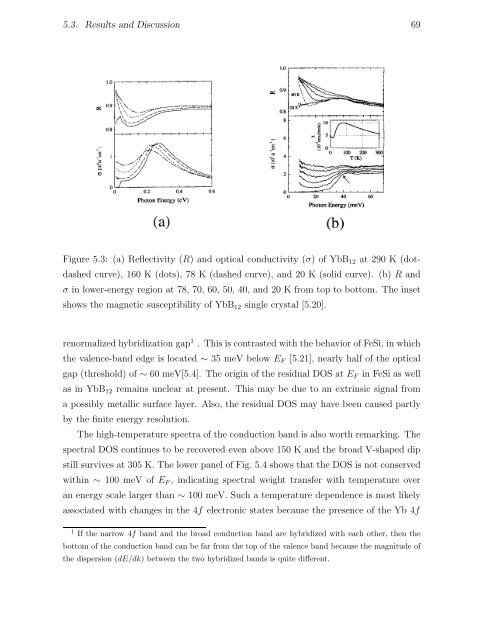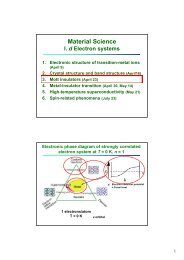Thesis High-Resolution Photoemission Study of Kondo Insulators ...
Thesis High-Resolution Photoemission Study of Kondo Insulators ...
Thesis High-Resolution Photoemission Study of Kondo Insulators ...
You also want an ePaper? Increase the reach of your titles
YUMPU automatically turns print PDFs into web optimized ePapers that Google loves.
5.3. Results and Discussion 69<br />
Figure 5.3: (a) Reflectivity (R) and optical conductivity (σ) <strong>of</strong> YbB12 at 290 K (dotdashed<br />
curve), 160 K (dots), 78 K (dashed curve), and 20 K (solid curve). (b) R and<br />
σ in lower-energy region at 78, 70, 60, 50, 40, and 20 K from top to bottom. The inset<br />
shows the magnetic susceptibility <strong>of</strong> YbB12 single crystal [5.20].<br />
renormalized hybridization gap1 . This is contrasted with the behavior <strong>of</strong> FeSi, in which<br />
the valence-band edge is located ∼ 35 meV below EF [5.21], nearly half <strong>of</strong> the optical<br />
gap (threshold) <strong>of</strong> ∼ 60 meV[5.4]. The origin <strong>of</strong> the residual DOS at EF in FeSi as well<br />
as in YbB12 remains unclear at present. This may be due to an extrinsic signal from<br />
a possibly metallic surface layer. Also, the residual DOS may have been caused partly<br />
by the finite energy resolution.<br />
The high-temperature spectra <strong>of</strong> the conduction band is also worth remarking. The<br />
spectral DOS continues to be recovered even above 150 K and the broad V-shaped dip<br />
still survives at 305 K. The lower panel <strong>of</strong> Fig. 5.4 shows that the DOS is not conserved<br />
within ∼ 100 meV <strong>of</strong> EF , indicating spectral weight transfer with temperature over<br />
an energy scale larger than ∼ 100 meV. Such a temperature dependence is most likely<br />
associated with changes in the 4f electronic states because the presence <strong>of</strong> the Yb 4f<br />
1 If the narrow 4f band and the broad conduction band are hybridized with each other, then the<br />
bottom <strong>of</strong> the conduction band can be far from the top <strong>of</strong> the valence band because the magnitude <strong>of</strong><br />
the dispersion (dE/dk) between the two hybridized bands is quite different.






